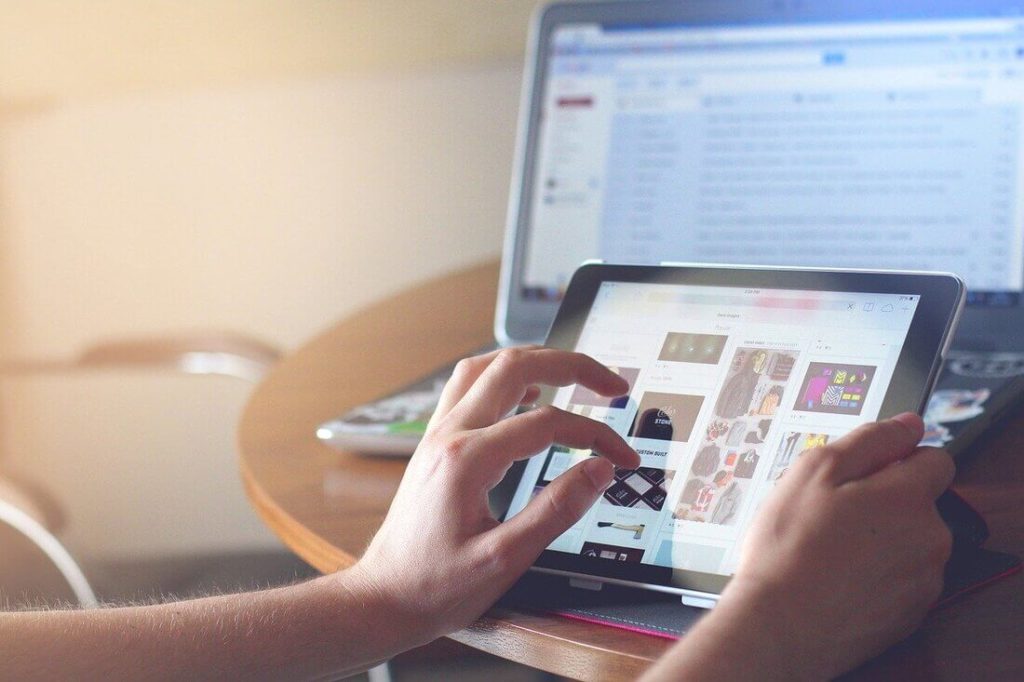
The visible light spectrum, which is the segment of electromagnetic radiation that we can see, consists of a range of colors – red, orange, yellow, green, blue, and violet. Each of these colors has a different energy and wavelength which can affect your eyes and vision. For instance, blue light rays, also called High Energy Visible (HEV) light, have shorter wavelengths and more energy. Often, this type of light can be very harsh and damaging to your eyesight, which is why it’s important to limit your exposure to blue light.
Exposure to Blue Light
Exposure to blue light can occur outside from the sun, or indoors from several digital devices and certain light bulbs. Some of these digital devices and lights include:
- Fluorescent Light
- Compact Fluorescent Light (CFL) bulbs
- LED Lights
- Flat Screen LED TV’s
- Computer monitors
- Smartphone screens
- Tablet screens
While the largest source of blue light comes from the sun, blue light also comes from digital devices which have become increasingly troublesome. That’s because of our constant overexposure to blue light from digital screens such as computer monitors and smartphones. There’s a much higher concern over the long-term effects of blue light that comes from screens because of the close proximity of the screens and the length of time spent looking at them. It’s also important to note that children’s eyes absorb more blue light than adults do. This means that their exposure to blue light can be even more damaging and will greatly affect their eyesight later in life.
Why We Need Blue Light
Although too much blue light can be harmful to your eyes, eye care professionals state that some blue light is needed to maintain your overall health. Some of the benefits of blue light include:
- Boosts your body’s alertness
- Helps with memory and cognitive function
- Elevates your mood
- Regulates your circadian rhythm (your body’s natural sleep/wake cycle)
- And not enough exposure could lead to development and growth delays
Remember to keep in mind that not all blue light is bad. Your body does need some blue light in order to function properly. However, when your eyes are overexposed to blue light, it can affect your sleep and cause irreversible damage to your retinas.
How Does Over-Exposure to Blue Light Affect You?
Almost all of the visible blue light that you experience will pass directly through the cornea and lens to reach the retina. This affects your vision and could prematurely age your eyes, causing damage that cannot be undone. Some of the effects blue light has on your eyes are:
Digital Eye Strain
Blue light from digital devices like computer screens, smartphone screens, and tablet screens, affects the contrast of light that our eyes take in. This decrease, in contrast, can cause digital eye strain which you’ll often notice when you spend too much time watching TV or looking at your computer or smartphone screen. Symptoms of digital eye strain may include sore or irritated eyes and difficulty focusing on images or text in front of you.
Retina Damage
Continuous vulnerability to blue light could lead to retinal cell damage which may cause certain vision problems. For instance, retinal damage is linked to eye conditions such as age-related macular degeneration, dry eye, and even cataracts.
Sleep Disturbances
Blue light is necessary for regulating your circadian rhythm – your body’s natural sleep/wake cycle. Because of this, it’s important that you limit your vulnerability to excessive blue lighting during the day and at night. Looking at your smartphone screen or watching TV right before bed will disrupt your body’s natural sleep pattern by unnaturally exposing your eyes to blue light. It’s normal to absorb natural blue light from the sun each day, which helps our bodies recognize when it’s time to go to sleep. However, if your body absorbs too much blue light later in the day, your body will have a harder time deciphering between night and day.
What To Do to Protect Your Eyes from Blue Light
While blue light is crucial to maintaining your body’s overall health, it’s important that you avoid over-exposure to blue light and here’s how you can do that:
- Limit and decrease your screen time when you can. And if you work in an industry that requires you to look at computer monitors or other digital devices for most of the day, try to take multiple small breaks in-between your screen time. This will give your eyes some much-needed alleviation throughout the day, and helps limit blue light exposure.
- Utilize screen filters that are available for smartphones, tablets and computer screens. They help decrease the amount of blue light that is emitted through your screen.
- Get yourself some computer glasses. Computer glasses are wearable lenses that are tinted yellow to help block out some of the blue light you’re exposed to while looking at a digital screen. The yellow helps increase contrast so the blue light is less harsh on your eyes.
- Or get yourself some anti-reflective lenses. This type of glasses helps reduce glare from digital screens and increases light contrast to block harsh blue lighting.
Connect with EyeZone Reno to Get Your Blue Light Glasses
Blue light glasses are tinted lenses with anti-glare protection that help limit exposure to blue light and reduce potential eye damage caused by blue lighting. They’re designed to help those who are constantly looking at digital screens and need an effective solution to reduce the damages caused by blue light. If you’re regularly exposed to computer screens, smartphone or tablet screens, or television screens, then connect with an eye care professional today at EyeZone Nevada! A Reno eye doctor will get the proper corrective lenses to prevent further damage and help give your eyes some much-needed comfort.

